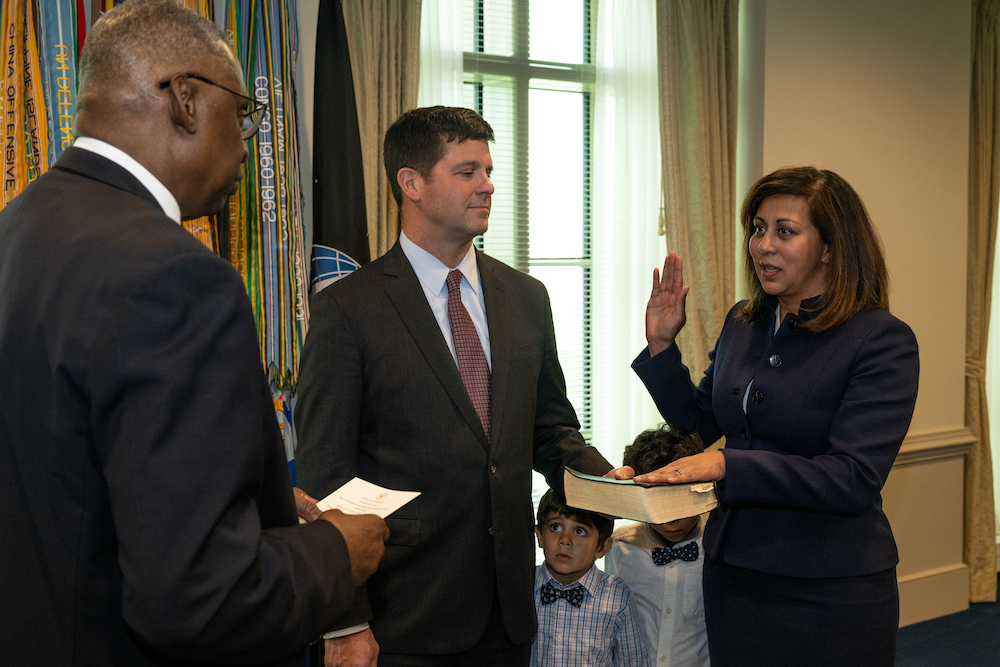How Tech Guides Defense Climate Strategy, Sustainability Efforts
Digital twin technology, data and software tools play a leading role in helping the Defense Department meet its 2030 and 2050 climate strategy benchmarks.

Around the globe, climate-related extreme weather events disrupt the Defense Department’s day-to-day operations, affect military infrastructure and influence the department’s future planning abilities.
In the last couple of years, wildfires caused damage to several military bases in California, Hurricane Laura impacted Fort Polk and Barksdale Air Force bases’ operations in Louisiana, and Hurricane Michael resulted in significant destruction to Tyndall Air Force Base in Florida.
In 2021, the White House issued an executive order on tackling the climate crisis at home and abroad, making climate change considerations a central part of the U.S. national security and foreign policy.
“Climate change is, in fact, changing the complexity of the sort of geostrategic environment that we find ourselves operating in today. … It just makes the complex things more complex,” said Acting Assistant Secretary of the Air Force for Energy, Installations, and Environment Edwin Oshiba in an interview with GovCIO Media & Research. “We have to understand sort of the impact that those kinds of events have on our ability to get our mission done, whether it’s here in the continental United States, whether it’s how we project power overseas, how it impacts our ability to operate in a distributed environment.”
The Navy is also honing in on the potential and what that means for its infrastructure, technology and personnel training. “I think climate change presents itself to navies in two vectors,” said Paparo, who serves as commander of the U.S. Pacific Fleet, during the conference. “I think the first and our most important vector is really its effect on our ports and on our airfields. … And then the second threat vector is its threat to populations.”” data-cke-saved-href=”The Navy is constantly facing threats from climate warming and what that means for its infrastructure, technology and personnel training. “I think climate change presents itself to navies in two vectors,” said Paparo, who serves as commander of the U.S. Pacific Fleet, during the conference. “I think the first and our most important vector is really its effect on our ports and on our airfields. … And then the second threat vector is its threat to populations.””>threats from climate warming and what that means for its infrastructure, technology and personnel training.
“I think climate change presents itself to navies in two vectors,” said Navy Adm. Sam Paparo at the AFCEA West conference hosted by AFCEA International and the U.S. Naval Institute in San Diego in February. “I think the first and our most important vector is really its effect on our ports and on our airfields. … And then the second threat vector is its threat to populations.”
To mitigate the impact of climate change at the Air Force, the service developed a comprehensive climate action plan outlining the strategy necessary to operate in changing climate conditions.
The Air Force climate action plan includes three priorities: maintaining air and space dominance in the face of climate risks, making climate-informed decisions and optimizing energy use while pursuing alternative energy sources.
“One of the driving factors that was really motivating us to get after this problem set and get out and publish a climate action plan is in the recognition of just how complex this environment has become,” Oshiba said.
Digital Twins for Eco-Friendlier Construction
Innovators across DOD are turning to new IT solutions, such as digital twin technology, to further sustainability goals around improving energy efficiency, reducing the department’s carbon footprint and limiting the department’s environmental impact.
Digital twin technology guides ongoing repairs of Tyndall Air Force Base to improve energy efficiency and limit waste of resources, setting a new standard for how DOD components use IT to modernize installations.
At the Army Corps of Engineers, Senior Scientific Technical Manager Lance Marrano served as the primary advisor for repairing Tyndall after Hurricane Michael destroyed most of the base in 2018 and caused more than $5 billion in damages. Given the enormity of the task, Marrano realized the repair teams needed more data and information at their fingertips to rebuild the base as quickly as possible while maintaining cost efficiency.
“Because of this immense reconstruction program, … the digital twin initiative was a way for us to catapult and have a catalyst to say, ‘How do we receive all of this new infrastructure data and use it to look at how we transform, how we make decisions about how to manage and operate the installation?’” Marrano said in an interview with GovCIO Media & Research.
A digital twin is essentially a virtual model of a physical construction, which allows engineers to tweak and optimize plans before commencing new construction. Digital twins rely on cloud computing and software services, and sometimes incorporate artificial intelligence (AI) and machine learning (ML) for predictive analytics.
Relying on a digital replica also helps planners limit waste of funds and opens up opportunities for environmentally friendly improvements in pursuit of sustainability goals.
Tyndall’s digital twin, for example, can help reduce carbon emissions at the base by simulating traffic peaks during construction to optimize traffic flow.
“At the peak of construction, we’re going to have a significantly large increase in the number of people that are going to be on the base,” Marrano said. “From an environmental perspective, you can think about how much time people wasted sitting in cars in queues to get through the gates. And so by being able to have the traffic simulation, we can look at what those sort of rush hour surges look like and use that to inform the base of how they can increase the number of gates that they open, increase the number of lanes that they have open, even inform leadership about some differences in telework schedule for the folks that are normally there every day that could work for that date in a telework status to optimize that flow of traffic across the base onto the base.”
Oshiba said rebuilding Tyndall allows DOD to design the base to be more fuel-efficient but also more resilient to future natural disasters.
“We have an opportunity now to kind of take a fresh look at what should the base of this feature or installation of the future look like?” he said during an interview with GovCIO Media & Research. “How can we design resiliency, for example, into our installation, into our facilities, so that if we know it’s going to be subjected to extreme weather events like hurricanes because of where it is, what can we do up front to design facilities to be more resilient in the face of those kinds of extreme weather events?”
Marrano’s applied expertise comes from years of research and development at the Army Corps of Engineers around what impact digital twin technology can have on the environment. Army Corps of Engineers Division Chief for Software Engineering and Informatics Ken Pathak said digital twin technology enables government to improve planning and resource allocation for building projects while addressing potential environmental concerns.
“Everybody has data, large quantities of data, but the problem is it’s so massive and unmanageable that the decision-makers are not able to make well-informed decisions because there’s no way a human being can take terabytes of data process in their brain and make a decision,” Pathak told GovCIO Media & Research in an interview. “Digital twins manipulate the data, pre-digest it in a certain way and focus and hone in on the questions we want to answer. It’s a human-machine interactive decision. We do take AI and ML and are able to predict some stuff based on historic data, then take real-time observations and merge them together. We can plan on it, line up funding for it, so we don’t have a problem.”
Digital twin technology also allows for “Tradespace” analytics, which can be described as cost versus urgency.
“You can do large-scale modeling with a system of digital twins for a structure or a lock and for the habitat, people and the community,” Pathak said. “When you build out a system of digital twins and couple digital twins together, the output from one can be the input for another one. You can do a large-scale study with digital twins to say, if I fix this [dam or lock] here, how will this affect salmon down the road?”
Pathak said the use cases for digital twins are unlimited, especially regarding sustainability and caring for the environment.
“Every time you construct, you can simulate emissions damage, which can be caused by construction, manufacturing, transportation,” he said. “We can do post-disaster simulations of the environment. You save environmental damage by not making a physical prototype in many cases. It’s really valuable to run these what-if scenarios [via digital twin]. Environmental modeling could be part of the system of digital twins when doing a project to gauge the environmental impact. Maybe you want to stretch out construction time or use different means. It has a very big impact.”
Data, Software Underpin Sustainability Efforts
As digital twin use cases continue to expand, data and software tools underpin a variety of DOD sustainability efforts.
Last year, the Army released its climate strategy implementation plan, and the Navy and Marine Corps launched Climate Action 2030, pledging to achieve net-zero greenhouse gas emissions by 2050.
The Air Force uses multiple tools to help predict extreme weather events and mitigate their impacts. The Defense Climate Assessment Tool (DCAT), a software tool DOD developed and one that all service branches use, helps the Air Force assess vulnerabilities that military installations are subjected to due to climate change.
“If, for example, we are trying to do an operational plan that requires us to maybe be a tenant or use an installation that belongs to the Army or to the Navy or the Marine Corps, being able to see what kind of climate risks we may be exposed to is helpful from a planning process,” Oshiba said.
DCAT data comes from authoritative government sources and is intended to provide information on a variety of weather-related events, such as hurricanes and tropical storms, droughts, wildfires and flooding.
“It is a great way to look at sort of exposure events or assess exposure at the local individual installation level as well as maybe, broadly speaking, at a regional level that we in the Department of the Air Force may not have the data for,” Oshiba said.
To support military operations, Oshiba said the team leverages the 14th Weather Squadron’s expertise to provide a cognitive data analysis and turn weather data into climate assessments for the Air Force. The 14th Weather Squadron, located in Asheville, North Carolina, is the Air Force’s only climate operations unit that collects and analyzes data gathered from various authoritative sources to support military operations around the globe.
In addition, the 14th Weather Squadron provides specialized weather support to agencies outside of DOD, including the National Oceanic and Atmospheric Administration (NOAA) and the Federal Emergency Management Agency (FEMA).
The Air Force also uses the DOD regional sea-level database, managed by the Naval Oceanographic Office, to help the Air Force plan ahead and provide up-to-date information on sea level or other ocean conditions.
“It kind of helps us look at potential projected future sea level rise assessments, say maybe in the South Pacific [where] we may want to be operating in the future,” Oshiba said.
The Climate Explorer tool, an analysis tool developed by NOAA, provides the Air Force with historical and projected climate data to help the Air Force plan for different climate variables such as sea level rise or precipitation levels in a specific region.
“There are certain aircraft operations that are very temperature sensitive, in terms of maybe limiting the amount of cargo you can carry if you’re operating in a really high-temperature environment. Certainly, the precipitation matters if you’re looking at potential flooding events, and so understanding how that works together might help,” Oshiba said.
As all of DOD aggressively pursues sustainability goals to meet 2030 and 2050 benchmarks, IT will play a leading role in those efforts.
“Technology plays a big part in how we can design our installations to be fuel-efficient, and maybe in some ways less contributing to the greenhouse gas emissions problem if you build it upfront,” Oshiba said. “My theory is that we have all the data we need to make good decisions. Our problem is to gather that data, integrate it, make it accessible in a way that helps us make better informed decisions. Working with DOD, we’ve set out some surveys to get an idea of what sort of knowledge or awareness people have on climate change so we know where to place our efforts going on to the future. This year is all about really kind of getting our baseline set.”
This is a carousel with manually rotating slides. Use Next and Previous buttons to navigate or jump to a slide with the slide dots
-

Cyber Resilience and Recovery Amid Evolving Cyber Threats
Data durability is a key aspect of NIST’s cybersecurity framework for public and private organizations.
21m listen -

The CAIOs Leading Responsible AI Development Across Government
Since the White House's AI executive order, federal agencies are in the process of naming chief artificial intelligence officers.
7m read -

Defense Board to Pitch Solutions for Closing Tech Talent Gaps
Defense Innovation Board members cite need to modernize people management the same way government modernizes technology.
4m read -

Energy Researchers Aim For Holistic Approach to AI Issues
A new center at the Oak Ridge National Laboratory is looking at under-researched areas of AI to better understand how to secure it.
2m read





